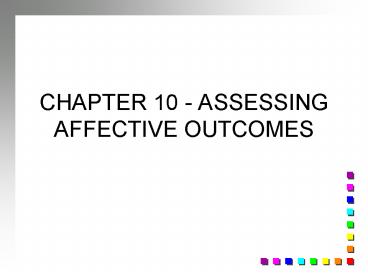CHAPTER 10 ASSESSING AFFECTIVE OUTCOMES - PowerPoint PPT Presentation
1 / 24
Title:
CHAPTER 10 ASSESSING AFFECTIVE OUTCOMES
Description:
CHAPTER 10 - ASSESSING AFFECTIVE OUTCOMES. I. Suggested ... Sociometry. I. Apperception methods (e.g. projective devices) J. Activity level. K. Observations ... – PowerPoint PPT presentation
Number of Views:1519
Avg rating:5.0/5.0
Title: CHAPTER 10 ASSESSING AFFECTIVE OUTCOMES
1
CHAPTER 10 - ASSESSING AFFECTIVE OUTCOMES
2
I. Suggested Uses of Affective Measures
- A. Classroom Application, e.g. career exploration
- B. Screening and selection, e.g. identify school
dropouts - C. Counseling, e.g. student self-exploration
- D. Research, e.g. relationship of test anxiety
and achievement - E. Program evaluation, e.g. effect of new math
program on self-concept
3
II. Approaches to the Assessment of Affective
Outcomes
- A. Amount of money spent on activity or product
- B. Amount of time spent in activity
- C. Verbal expressions (e.g. attitude scales)
- D. Attention/distraction
4
- E. Fund of information
- F. Reaction/decision time
- G. Personal document analysis (e.g. diaries)
- H. Sociometry
5
- I. Apperception methods (e.g. projective devices)
- J. Activity level
- K. Observations
- L. Specific performances/behaviors
6
- M. Physiological measures
- N. Memory measures
- O. Simulation
7
III. Writing Items for Self-Report Affective
Measures
8
- A. Considerable overlap with guidelines for
writing test items, e.g. - 1. Avoid complex and ambiguous language
- 2. Avoid universals and absolutes, (e.g. all,
none) - 3. Avoid multiple ideas and negatives
- 4. Avoid items reflecting universal acceptance
or rejection
9
- B. In addition statements should
- 1. Refer to the present
- 2. Not be factual
- 3. Reflect a range of affectivity
10
IV. Corey's Simplified Scale Construction
Technique
11
- A. Collect pool of statements reflecting range of
attitudes - B. Select best statements
- C. Create response scale (e.g., five point verbal
scale Strongly Agree, Agree, Neutral, Disagree,
Strongly Disagree) - D. Pilot test instrument
- E. Score, taking into account direction of
statement (e.g. Agree with positive statements,
Disagree with negative statements)
12
V. Method of Summated Ratings (Likert)
- A. Similar to Corey method but
- 1. Have judges evaluate degree of favorableness
of statements (80 agreement) - 2. Use item analysis technique to select items
(e.g. mean difference in rating of particular
statement for high and low scorers based on total
score)
13
VI. Free Response and Opinionnaire Methods
- A. Require carefully focused questions to avoid
"wandering"
14
- B. Enjoy advantages of
- 1. Face validity
- 2. Feeling of "ownership of response" - "these
are my words" - 3. "Directness" of purpose and response
15
- C. Disadvantages include
- 1. Labor to analyze - content analysis
- 2. Problems in aggregating data
- 3. Subjectivity in analyzing responses
16
- D. When constructing questions try
- 1. To be brief
- 2. Not to suggest an answer
- 3. To phrase questions broad enough to allow
respondent to express range of opinion - 4. To limit length
17
- 5. To make sure respondent understands purpose
of questionnaire - 6. To control administration
- 7. To pilot/field test items and instruments
18
- E. Content analysis of free response material
- 1. Identify units of analysis (e.g. sentence)
- 2. Group units into categories
- 3. If possible have independent analyses by two
or more evaluators - 4. Summarize data in form of frequencies and
percents - 5. Get sample size as large as practical
19
VII. Affective Measurement and the Diagnosis of
Learning Difficulties
20
- A. Affective measures find application in
- 1. Classroom
- 2. Screening and selection
- 3. Counseling
- 4. Research
- 5. Program evaluation
21
- B. In counseling applications tend to be in the
area of - 1. Educational planning
- 2. Career planning
- 3. Life planning
- 4. Personal development
22
- C. Diagnosis of learning difficulties also
possible with affective measures (e.g. attitude,
interest). Process involves - 1. Use of variety of approaches
- 2. Identification of problem
- 3. Hypothesis generation
- 4. Assessment
- 5. Diagnosis
- 6. Remediation
23
- D. Some concerns and cautions in using affective
measures - A. Foremost concern is with relevance
- B. Need for standardized scoring and
interpretation of voluntary administration - C. Protection of individual rights and against
invasion of privacy by full disclosure of purpose
(confidentiality)
24
- D. Careful about applicability of norms
- E. Be sure to examine reliability and validity
data - F. Never use test score alone





























